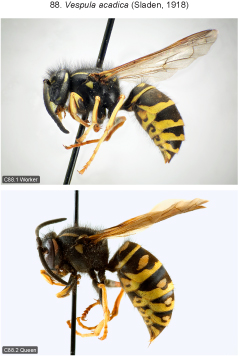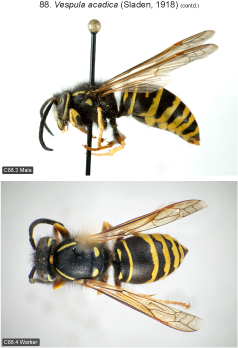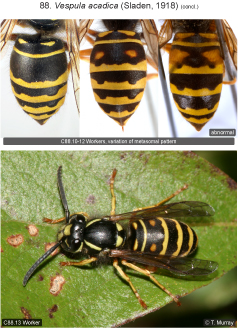
| Home | Table of contents | Keys | Species list | Glossary | Image data | PDF | Cite this article | Feedback | Updates |
Identification Atlas of the Vespidae (Hymenoptera, Aculeata) of the northeastern Nearctic region
CJAI 05, February 19, 2008
doi: 10.3752/cjai.2008.05
Matthias Buck, Stephen A. Marshall, and David K.B. Cheung
Department of Environmental Biology, University of Guelph, Guelph, Ontario, Canada N1G 2W1
Next species | Previous species | Key
88. Vespula acadica (Sladen, 1918)
Figs B1.14; B13.7, 9, 11, 37–39, 61, 72; C88.1–13.
 |
 |
 |
 |
 |
Species recognition. About 50% of workers and males and nearly all queens possess a pair of yellow to obscure brown spots enclosed within the black fascia of sternum 2 (absent in other Vespula species except rarely in males of V. austriaca, a very rarely collected social parasite). Further differences between V. acadica and similar species of the V. rufa-group (V. vidua, V. austriaca) are discussed under these species.
Variation. Fore wing length 8.5–10.0 mm (workers), 12.0–13.0 mm (♀♀, n = 7), ca. 11.0–13.0 mm (♂♂, n = 9). Black clypeal mark of female extending to dorsal margin of clypeus, in worker rarely to ventral margin of clypeus, in males clypeal mark usually free or extending to both dorsal and ventral margins. Yellow stripe along inner orbit ending near apex of ocular sinus, in males often extending far along upper margin of sinus. Female with lower gena black, often enclosing a small to medium-sized yellow spot ventrally; male with a yellow postocular band that is sometimes interrupted near middle. Metanotum with or without a pair of yellow spots in female, absent in male (always?). Propodeum in worker rarely with a pair of evanescent yellow spots. Pair of enclosed yellow spots near summit of tergum 1 almost always present (absent in one aberrant male from ON, Bruce Co., Inverhuron Prov. Pk., DEBU). Enclosed yellow spots present in about half of workers and males, and almost all queens; the spots sometimes more or less suffused with brown and evanescent. Queen generally with enclosed yellow spots on terga 3–5 as well; in xanthic specimens sometimes narrowly connected to apical fascia. One aberrant worker (ON, Bruce Co., Dorcas Bay, DEBU; Fig. 88.12) shows brownish suffusions to tergum 2 of similar extent as in V. rufa (which is marked with ivory instead of yellow).
Distribution. Canada: all provinces and territories except NU. Northern U.S. including AK, south to NC, TN, WV, MI, WI, MN, NE, NM, AZ and CA (Carpenter and Kojima 1997).
Biology. Nests are usually built in rotten logs, under logs or in the soil; aerial nests are uncommon. Females prey on live arthropods only. Due to its silvicolous habitat preferences and primarily boreo-montane distribution V. acadica rarely comes into contact with man and is therefore not a nuisance species (Akre et al. 1981).
Next species | Previous species | Key
| Home | Table of contents | Keys | Species list | Glossary | Image data | PDF | Cite this article | Feedback | Updates |
